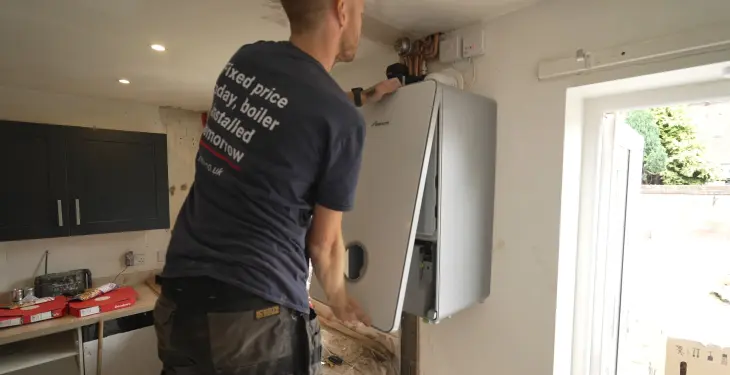

Written by Stephen Day
Gas Safe Engineer
Updated: 30th May, 2025
Navigating boiler error codes can be puzzling yet essential for preserving a fully functioning heating system. These codes pinpoint specific issues within the boiler, guiding towards swift and accurate remediation.
Get a new boiler quote, save up to £550 per year (0% APR available).
When Potterton boiler users encounter the E119 error code, it indicates a problem that is common enough to warrant attention but simple enough to often be fixed without professional intervention.
The E119 error code specifically points to low boiler pressure in the central heating system, which can prevent the boiler from functioning correctly. This code is often displayed prominently on the boiler's control panel, alerting users to the issue at hand. Users may notice that the heating is not operating effectively, and upon checking, find the error code presented as a diagnosis.
Low boiler pressure can be a result of various factors such as leaks in the system, recently bled radiators, or a failing pressure relief valve. Identifying and correcting the cause of this drop in pressure is essential to restore the boiler to working order.
Re-pressurising the system is a typical remedy for this fault code. Homeowners might repressurise their boiler themselves by following the manufacturer’s instructions, assuming they are familiar with their system, or they may decide to call in a Gas Safe registered engineer, particularly if they are unsure of the cause or if repressurisation does not resolve the issue.
Get a quote in 60 seconds, fitted as fast as next day!
0% APR finance available.
Navigating boiler error codes can be puzzling yet essential for preserving a fully functioning heating system. These codes pinpoint specific issues within the boiler, guiding towards swift and accurate remediation.
Boiler error codes, often displayed on the unit's digital panel, are alphanumeric sequences that represent particular fault conditions within the heating system. They emerge when the boiler's internal diagnostics detect an anomaly that prevents normal operation. Each code corresponds to a distinct problem, ranging from minor sensor glitches to pressing system failures. It is the heating system's method of communicating its health status to the user.
Thorough knowledge of error codes is indispensable for effective boiler maintenance. It empowers homeowners and technicians alike to perform accurate diagnosis and undertake appropriate corrective measures. Error or fault codes can illuminate the root cause of a malfunction, thereby facilitating a targeted approach to rectify the issue. Moreover, early recognition and resolution of fault codes can avert potential future complications, ensuring the longevity and efficiency of the boiler. Understanding these codes is a preventive safeguard, bolstering the reliability of the boiler's operation.
The e119 error code on a Potterton boiler primarily indicates a problem with the water pressure—often, it's too low for optimal operation. This crucial cue helps homeowners identify a specific state of dysfunction within their heating system.
The e119 fault code is a distinct indicator that manifests when your Potterton boiler detects low water pressure levels. It's a common code specific to the Potterton and Baxi range of boilers, and it can halt the normal functioning of your heating system. The boiler's pressure gauge, typically located on the front panel, gives a direct reading of the current water pressure levels. If the gauge indicates below the recommended pressure, the system automatically shuts down to prevent damage, displaying the e119 alert.
There are several causes that may lead to the appearance of the e119 error code on a Potterton boiler:
Leaks: A leak within the central heating system, including the radiators and connecting pipes, can lead to a decrease in water pressure.
Valves: Problems with the valves, such as a defect in the filling loop, can prevent the system from maintaining the correct pressure.
Sensor Malfunction: A fault in pressure sensors can also result in erroneous low water pressure readings, triggering the error code.
Condensate Pipe Issues: In colder weather, the condensate pipe might freeze, impeding the boiler's operation and potentially contributing to pressure loss.
Repressurising the system is the most straightforward fix for the e119 fault code, however, the underlying cause must be addressed to prevent recurrence. It's important to reset the boiler using the reset button after resolving the pressure issue. If pressure continues to drop after repressurisation, it's indicative of a persistent leak or component failure, necessitating professional inspection and repair.
Identifying an E119 error code on a Potterton boiler can often be straightforward due to certain tell-tale signs. One primary indicator is the boiler ceasing to function, which prompts the display to show the E119 fault code. This code signals specific issues related to boiler pressure.
Low Boiler Pressure: The core symptom linked to the E119 code is a drop below the optimal pressure range, which is typically between 1.0 and 1.5 bar. The pressure gauge on the front panel of the boiler, visible through a sight glass or a digital display, will reflect this deficiency.
Hot Water and Central Heating Disruption: In the wake of such a drop in pressure, users may find their hot water supply and central heating performance are compromised. Taps might deliver lukewarm water, while radiators struggle to warm up or remain cold at the bottom.
Potential Leaks: Low pressure can occasionally hint at a leak within the boiler or the associated pipework. While not always visible, leaks can sometimes manifest as damp patches near the boiler or along the pipework, demanding prompt inspection.
Inspection of Radiators: Operational anomalies in the radiators, such as partial heating or noises, could also be indicative of pressure-related issues. Regular inspection and bleeding of radiators can avert these disruptions.
Acknowledging these signs promptly and responding effectively ensures the continued efficiency and longevity of the Potterton boiler. Regular maintenance checks can help in early detection and prevention of the E119 fault, preserving the cosy comfort of a home's central heating and hot water supply.
Potterton boilers may display an E119 error code signalling low water pressure; a problem often remedied through basic repressurising steps. Many individuals can carry out this fix with caution, though certain scenarios necessitate professional intervention.
Steps to Repressurise the Boiler:
Switch off the boiler and wait for it to cool down to avoid burns.
Check the pressure gauge; if it reads below 1 bar, proceed to repressurise.
Locate the filling loop or valve beneath the boiler.
For models with a green lever, depress to allow water into the system.
Monitor the gauge and stop once it reaches 1 to 1.5 bar.
Remember, gentle increments are key to avoiding over-pressurisation. After repressurising, reset the boiler and observe if the error code persists.
While many pressure-related issues are solved with a simple DIY fix, certain conditions should prompt you to seek expert assistance:
Recurring Error Code: If E119 reappears frequently, it may suggest a leak within the system, which requires a professional diagnosis.
Water Leakage: Should you notice any water around the appliance, refrain from attempting a fix and contact an engineer immediately.
Uncertain Procedures: If you are unsure about any steps or the boiler's components, it is safer and more assured to obtain a boiler quote for a repair rather than risking further damage.
Regular maintenance can prevent these issues, and as it stands, an expert's insight can be invaluable, especially when your own efforts do not resolve the error code.
If a Potterton boiler displays the E119 error code, it indicates a need to address low system pressure. While some pressure issues can be corrected by homeowners, other scenarios necessitate professional intervention.
Minor Adjustments: Homeowners can often repressurise their boiler by following the manufacturer's instructions. This involves adjusting the pressure valves and monitoring the boiler's pressure gauge.
Persistent Issues: If the error recurs or the boiler’s pressure drops rapidly after repressurisation, this could signal a deeper issue, such as a leak. In this circumstance, summoning a Gas Safe registered heating engineer—a professional—is imperative.
Safety Concerns: Anytime gas appliances are involved and there's uncertainty or discomfort in addressing the issue, immediately seek a Gas Safe engineer. Safety must be the foremost priority.
A Gas Safe engineer is a specialist certified to work safely on gas boilers in the UK. This mandatory certification:
Validates Competency: Engineers must prove their technical skills to earn Gas Safe registration.
Ensures Safety: Given that gas-related work holds inherent risks, a registered engineer's expertise is vital to preclude potential gas leaks or carbon monoxide issues, safeguarding household occupants.
Upholds Warranty: Most boiler warranties specify that repairs must be executed by a qualified Gas Safe engineer, maintaining warranty validity.
The decision to contact a Gas Safe registered heating engineer should be guided by the nature of the E119 error, the homeowner’s competency in performing minor adjustments, and the overarching need for safe and regulation-compliant repair work.
Identifying and rectifying the E119 error code on a Potterton boiler involves costs that vary based upon a number of factors. This section will explore the typical cost range and examine what could influence the final price.
Diagnostic Charge: Service engineers may charge an initial diagnostic fee to identify the E119 error code, which is generally around £50 to £100.
Repressurising the Boiler: If the issue is simple and requires only repressurisation, this can often be done by homeowners themselves at no cost. Otherwise, a service engineer may charge a small fee as part of a service call out.
Part Replacements and Repairs: Should parts need replacement or repairs beyond repressurisation, costs can vary from £150 to £500, depending on the part and its availability.
Severity of Issue: If the E119 error code indicates a more serious problem, such as a significant leak or pressure vessel damage, the cost will rise.
Age and Model of the Boiler: Older boilers or discontinued models might have higher repair costs due to the lower availability of parts.
Labour Costs: The rate charged by service engineers varies. Rates in London and the Southeast may be higher than the rest of the UK.
Boiler Service History: A well-maintained boiler might only need minor adjustments, whereas a neglected one could incur higher repair costs.
Emergence of Other Fault Codes: If an E133 or similar error code occurs in conjunction with E119, this indicates additional issues, potentially requiring more extensive repairs and thus increasing costs.
Do remember that occasionally, when the repair costs approach the price of a new boiler, getting a quote for a new system may be a more cost-effective solution in the long run.
When a Potterton boiler flashes the E119 error code, indicating low water pressure, it's not always clear if a repair will suffice, or if it's time for a new boiler. Decisiveness in this situation relies on understanding the specifics of boiler health and longevity.
Age of the Boiler: If a boiler is nearing the end of its typical lifespan, which usually hovers around 15 years, frequent repairs might suggest that a replacement is more economical.
Repair Frequency: A boiler necessitating frequent repairs, especially if those repairs are becoming costlier, implies it may be time to consider a new one.
Performance Issues: Should the boiler struggle to maintain water pressure despite repairs or regularly displays fault codes like E118 for pressure issues or E119, then one must weigh the efficiency losses against the cost of a new boiler.
Boilers manufactured by renowned UK firms, including Baxi, a subsidiary of BDR Thermea, come with warranties often spanning from 7 to 10 years. Whilst a well-maintained boiler can last up to 15 years, several signs point towards replacement rather than repair:
Efficiency Decline: An old boiler may no longer efficiently heat your home, leading to increased energy bills.
Parts Availability: Older models may have discontinued parts, making them harder and more expensive to repair.
Warranty Expiration: Post-warranty, you bear the full costs of any repairs, which can add up quickly compared to the predictable cost of a replacement boiler with a fresh warranty.
In England, upgrading to a new, efficient combi boiler is a consideration many take, for not only home comfort but also financial and energy efficiency reasons.
In addressing the E119 error code on Potterton boilers, key points involve understanding that this code signals low water pressure within the system. Homeowners can typically rectify this by repressurising their boilers to the recommended setting of 1 to 1.5 bar. It is essential to locate the boiler's pressure gauge to accurately assess the current pressure level.
Regular maintenance is crucial in preventing the recurrence of such issues. It includes monitoring boiler pressure and performing routine checks. Should the error persist, underlying causes might involve leaks or faulty pressure sensors, wherein professional help is advisable.
For longevity and efficiency of your heating system, familiarise yourself with your boiler’s maintenance schedule. While Potterton boilers are known for reliability, diagnosing the E119 error code and swiftly resolving it ensures disruption-free operation. Remember, consistent attention to your boiler’s condition wards off unexpected breakdowns and costly repairs.
Lastly, homeowners are encouraged to consult their boiler manual for company-specific repressurisation instructions or reach out to certified technicians when in doubt. A proactive approach to boiler care keeps the warmth flowing and peace of mind intact.
Last updated: 30th May, 2025

Written by Stephen Day
Gas Safe Engineer at iHeat
Stephen Day is a Gas Safe registered and FGAS certified engineer with over 20 years of hands-on experience in the heating, cooling, and renewable energy industry, specialising in boiler installations, air conditioning, and heat pump systems.
LinkedInArticles by Stephen Day are reviewed by iHeat’s technical team to ensure accuracy and reliability.

22nd December, 2025
Based on data from over 7000 boiler installations completed by iHeat in the past 12 months...
 Read Article
Read Article

22nd December, 2025
Here’s a quick roundup of the best combi boilers for 2026.
 Read Article
Read Article

22nd December, 2025
When your old boiler breaks down and it comes time to replace it with a new one, it might...
 Read Article
Read Article
No obligation. Takes less than 60 seconds.